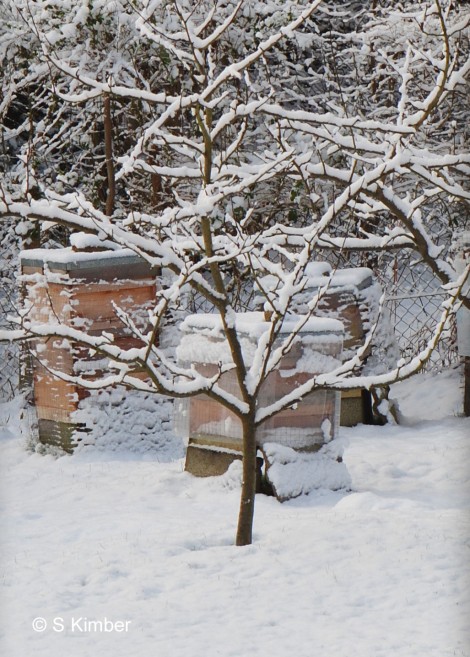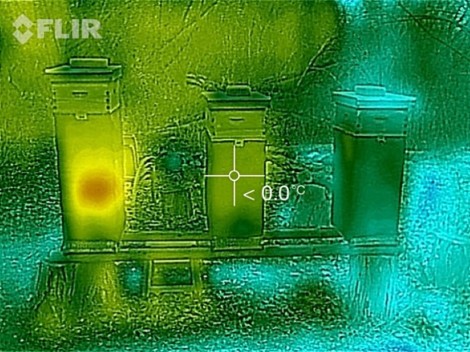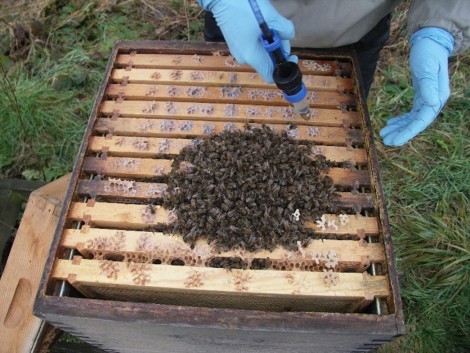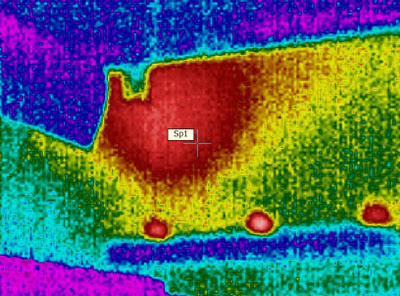 Abraham Lincoln
If given the truth, the people can be depended upon to meet any national crisis...
Abraham Lincoln
If given the truth, the people can be depended upon to meet any national crisis...
 Guildford news...
for Guildford people, brought to you by Guildford reporters - Guildford's own news service
Guildford news...
for Guildford people, brought to you by Guildford reporters - Guildford's own news service
Beekeeper’s Notes December 2015 – Cluster Buster
Published on: 1 Dec, 2015
Updated on: 29 Nov, 2015
Hugh Coakley, from Worplesdon, writes about what bees get up to in the winter!
People often ask if honey bees hibernate during the winter.
Well, the simple answer is that they don’t.
Honey bees keep flying and doing whatever bees do throughout the year – as long as the weather allows. They also nip out whenever they can to defecate on the wing – those little yellow spots on your washing could be bee poo!
The weather does need to be sufficiently warm, above about 10oC, dry and not too windy. My bees were out in great numbers at the end of November and it was lovely to see.
Bumble bees hibernate, as do wasps. So, if honey bees don’t hibernate, how do these cold-blooded insects survive the extremes of winter cold?

Beehives in Godalming in February 2012 covered in snow with the temperature below freezing. The bees are perfectly adapted to these winter conditions. Photo by Susan Kimber, photographer and beekeeper.
Bees are found in every continent on earth – except Antarctica (if Antarctica is a continent). We are familiar with the thought of bees in warm or temperate countries. Less well known is that bees also thrive in very cold places like Scandinavia, Russia and even the Arctic.
Their answer is very clever. They cluster together in a tight, round mass to keep themselves warm.

Thermal image of beehives in the USA in winter. The hive on the right is empty. The hive in the middle has a weak honey bee colony which probably won’t survive the winter. The hive on the left is a strong colony actively keeping warm in a nice, tight cluster. Courtesy of The Honey Bee Suite.
The bee cluster is more or less spherical – minimising surface area and therefore heat loss. The bees are densely packed on the outside and more loosely packed within.

Beehive opened up revealing the cluster of bees, about 9in in diameter.
The cluster is in constant movement with those on the outside moving inside before they get too cold, always keeping the queen warm. Those on the inside take their turn on the outside of the sphere. The inside of the cluster is kept at a sufficiently warm temperature to continue normal activities of rearing young and feeding even if egg laying by the queen is very much reduced over the winter.

Thermal image of bees clustering in a hive in cold conditions. You can make out the straight edges of the hive roof, the cold exterior (blue) and the warm (red) sperical cluster of bees within.
One danger with the cluster is that, in the coldest of weather, it can’t reform if it is broken. Beekeepers are very aware that they mustn’t move hives in the cold because if they bust the cluster, they have a very good chance of losing the bees. The individual bees will just get too cold to move back into a huddle and they will die.
So the honey bee, who has been successfully surviving on planet earth for about the last 10 million years, has the means to survive pretty much anything that nature throws at it, including very cold winters.
As long as we don’t bust the cluster!

Click on cartoon for Dragon story: Public Asked for Views on SCC’s Proposal for Reduced Speed Limits



Recent Articles
- Letter: The Weyside Scheme Is Not Going To Be GBC’s Woking
- Guildford’s First “Bike Bus”
- Incident in High Street
- Notice: Free Bandstand Concerts
- Councillors Hear How the Weyside Urban Village Project Became a Multi-million Risk
- NHS Surrey Issue Heatwave Advice Following Met Office Warning
- Guildford Charity’s Tribute To The Great Stevie Wonder
- Busy First Half of 2025 for Scouting in Guildford
- Dragon Interview: MP Zöe Franklin Reviews Topical Issues
- Letter: Front-line Police Officers Are Heroes But Admin and Comms Need Improvement


Search in Site
Media Gallery
Dragon Interview: Local Artist Leaves Her Mark At One of England’s Most Historic Buildings
January 21, 2023 / No Comment / Read MoreDragon Interview: Lib Dem Planning Chair: ‘Current Policy Doesn’t Work for Local People’
January 19, 2023 / No Comment / Read MoreA3 Tunnel in Guildford ‘Necessary’ for New Homes, Says Guildford’s MP
January 10, 2023 / No Comment / Read More‘Madness’ for London Road Scheme to Go Ahead Against ‘Huge Opposition’, Says SCC Leader
January 6, 2023 / No Comment / Read MoreCouncillor’s Son Starts Campaign for More Consultation on North Street Plan
December 30, 2022 / No Comment / Read MoreCounty Council Climbs Down Over London Road Works – Further ‘Engagement’ Period Announced
December 14, 2022 / No Comment / Read MoreDragon Interview: GBC Reaction to the Government’s Expected Decision to Relax Housing Targets
December 7, 2022 / No Comment / Read MoreHow Can Our Town Centre Businesses Recover? Watch the Shop Front Debate
May 18, 2020 / No Comment / Read More






Recent Comments